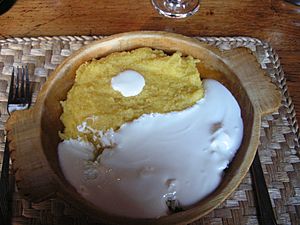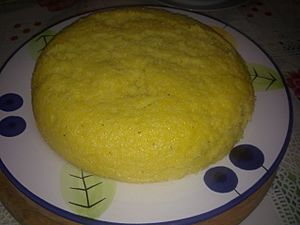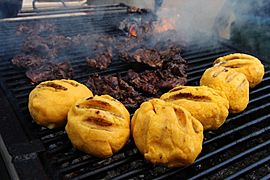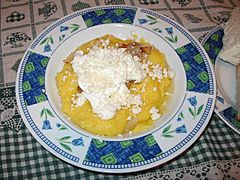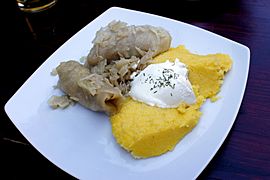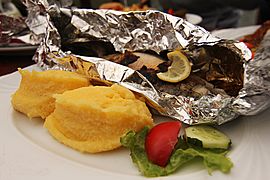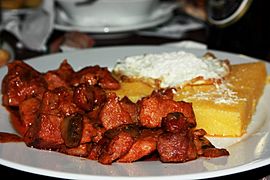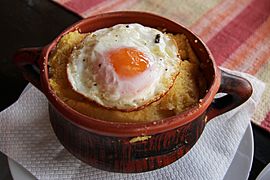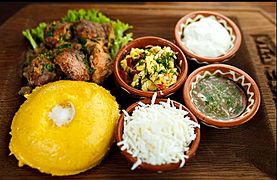Mămăligă facts for kids
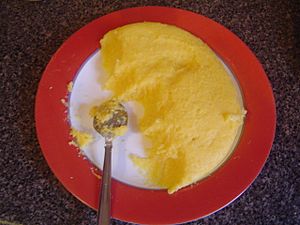 |
|||||||
| Course | Main course | ||||||
|---|---|---|---|---|---|---|---|
| Place of origin | Romania | ||||||
| Region or state | Romania, Moldova, Ukraine | ||||||
| Main ingredients | |||||||
| 70 kcal (293 kJ) | |||||||
|
|||||||
| Similar dishes | |||||||
Mămăligă (Romanian pronunciation: [məməˈliɡə]) is a tasty porridge made from yellow maize flour. It's a traditional dish in Romania, Moldova, and West Ukraine. Even Poles from the Lviv area enjoy this dish. You can also find it in Thessaly and Fthiotis, Greece. In many other countries, like Italy and Switzerland, it's known as polenta.
Contents
History of Mămăligă
Mămăligă was once a simple meal for farmers. It was often eaten instead of bread. For many poor families in the countryside, it was their main food. But over the years, it has become a fancy dish. Now, you can find it in some of the best restaurants!
Ancient Grains and Roman Influence
Eating porridge is actually one of the oldest ways humans have eaten grains. People made porridges long before they learned to bake bread. In ancient times, they used different seeds like millet or einkorn.
Before corn came to Europe in the 1500s, mămăligă was made with millet flour. The ancient Romans called this kind of millet porridge pulmentum.
How Corn Came to Romania
Maize, also known as corn, arrived in Spain in 1530. It was brought by Hernán Cortés from Mexico. From Spain, corn slowly spread across Europe in the 16th century. Corn needs lots of warmth and moisture to grow well. The Danube Valley in Romania is a perfect place for it.
A Hungarian expert wrote about corn arriving in Timișoara in 1692. In Transylvania, corn is sometimes called 'cucuruz'. This word might come from a Slavic word, showing a link to Serbian traders. Some people believe important leaders like Șerban Cantacuzino or Constantin Mavrocordat brought corn to Wallachia. Maria Theresa brought it to Transylvania, and Constantine Ducas to Moldavia. In Moldavia, corn is called păpușoi.
Over time, mămăligă made from millet was slowly replaced by mămăligă made from corn. Corn became a very important food. It helped people survive during times of hunger in the 17th and 18th centuries.
Historian Nicolae Iorga said that Romanian farmers were growing corn by the early 1600s. An old French dictionary from 1873 also mentions corn-based mămăligă in the Danube region.
Making Mămăligă
To make traditional mămăligă, you boil water, add salt, and then stir in cornmeal. It's usually cooked in a special cast iron pot called a ceaun or tuci.
When farmers made it as a bread substitute, mămăligă was very thick. You could even cut it into slices, just like bread. For other meals, mămăligă can be softer, almost like a creamy porridge. Because it can stick to metal, people often use a piece of sewing thread to cut it. Then, you can pick it up and eat it with your hands, just like bread!
Mămăligă is a very flexible food. You can add many things to it, like milk, butter, different kinds of cheese, eggs, sausages, bacon, mushrooms, or fish. It's also a healthy choice because it has no fat or cholesterol and lots of fiber. It can be a good alternative to white bread or pasta.
Serving Mămăligă
Mămăligă is often served with sour cream and cheese. This dish is called mămăligă cu brânză și smântână. Another way to eat it is crushed in a bowl of hot milk, known as mămăligă cu lapte. Sometimes, slices of mămăligă are fried in oil or lard. This makes a crispy corn pone.
It's also a common side dish for meat, especially pork stew called "tocana." Or you can have it with fried fish and "mujdei," which is a garlic sauce.
Dishes Similar to Mămăligă
Since mămăligă can replace bread in many Romanian and Moldovan dishes, it's used in many ways. One of the most popular dishes is sarmale, which are cabbage rolls, served with mămăligă.
Another favorite Romanian dish is called bulz. This is mămăligă mixed with cheese and butter, then roasted in the oven.
Balmoș is another traditional Romanian dish, similar to mămăligă but more complex. For balmoș, the cornmeal is boiled in sheep milk instead of water. Other ingredients are added, like butter, sour cream, and different types of cheese. It was a special dish made by old Romanian shepherds. Today, not many people know how to make a real balmoș.
Fun Facts About Mămăligă
- A thin porridge made of cornmeal, water, milk, butter, salt, and sugar is called cir de mămăligă. If it's very thin and only has cornmeal, water, and salt, it's called mieșniță or terci.
- The Romanian word mălai can mean a few things:
- Corn flour is called mălai or făină de porumb in Romanian.
- Before corn arrived in Eastern Europe, mămăligă was made from millet flour. This old millet mămăligă is now becoming popular again in Western Europe.
- Mămăligă is mentioned many times in Aaron Lebedeff's Yiddish song Rumania, Rumania. In Yiddish, it's spelled מאַמאַליגע.
Mămăligă in Books
In Chapter One of Dracula by Bram Stoker, the main character says: "I had for breakfast more paprika, and a sort of porridge of maize flour which they said was ‘mamaliga’..." This shows that mămăligă was a well-known food even back then.
Other Similar Dishes Around the World
Mămăligă is very similar to the Italian dish polenta. Polenta is also very popular in Brazil.
In some parts of the United States, a similar dish is called cornmeal mush. In the southern U.S., it's known as grits.
In Serbia and Bulgaria, a similar dish is called kačamak. It's often served with white cheese or fried pork rinds.
In Bosnia and Herzegovina, Croatia (where it's also called polenta or palenta), Serbia (also kačamak), and Montenegro, the dish is mainly called pura. In North Macedonia, it's bakrdan, and in Slovenia, it's polenta.
Hungarians call their version puliszka.
In Turkey, a similar dish called kuymak or muhlama is popular, especially in the Black Sea Region.
Broccoliga is a new version of Mămăligă. It mixes broccoli and polenta with cheddar cheese and herbs.
Similar dishes are also found in Caucasian cuisine. They have different names like abysta (Abkhazian) or ghomi (Georgian).
There's also a clear link to cou-cou in Barbados and fungi in Antigua and Barbuda. These are found in the Caribbean Sea.
This type of cornmeal dish is eaten widely across Africa too. Often, it's made with white corn flour instead of yellow. It has many different local names, such as:
- Akamu – Igbo, Nigeria
- Arega - Kenya, Luo
- Bando - Soga, Uganda
- Bidia – DR Congo
- Bogobe/Phaletšhe – Botswana, South Africa
- Bugali – Burundi, DR Congo, Sudan, South Sudan Rwanda
- Buhobe – Lozi
- Buru – Kenya, Luo
- Busima-Bagisu, Uganda
- Chenge – Kenya, Luo
- Chima – Mozambique
- Couscous de Cameroon – Cameroon
- Dona
- Fitah - Sudan, South Sudan, Congo
- Fufu - Sierra Leone
- Isitshwala – Botswana, Ndebele
- Kawunga - Ganda, Uganda
- Kimnyet – Kalenjin, Kenya
- Kuon – Kenya, Luo
- Kwen wunga - Alur, Uganda
- Lipalishi – Eswatini
- Mielie pap – Lesotho,'' South Africa
- Mogo – Kenya, Luo
- Moteke – DR Congo
- Mutuku – South Africa
- Nfundi – Congo
- Ngima – Kamba, Kenya, Kikuyu
- Nkima – Kenya, Meru
- Nshima- DR Congo Kasai region
- Nsima – Malawi, Zambia
- Obusuma – Kenya, Nyole
- Ogi – Nigeria, Yoruba
- Oshifima – Namibia
- Pap – Namibia, South Africa
- Papa – Lesotho, South Africa
- Phaletšhe – Botswana
- Phuthu – South Africa
- Posho – Uganda
- Poshto – Uganda
- Saab – Ghana, Kusasi
- Sadza – Shona and Kalanga, Zimbabwe and Botswana
- Sakora – Nigeria
- Sakoro – Ghana
- Sembe - Tanzania, slang
- Sembe – Kenya, slang
- Shadza – Kalanga, Botswana
- Shima
- Shishima - Zambia
- Sima – Chewa, Tumbuka, and Ngoni
- Soor – Somalia, Zambia
- Tuozafi (or T.Z.) – Ghana
- Ubugali – Rwanda
- Ubwali – Bemba
- Ugali – Kenya, Malawi, Mozambique, Tanzania, Uganda, Yao, Swahili
- Um'ratha – Ndebele
- Upswa – Mozambique
- Vbogobe – Sotho, Tswana
- Vhuswa – Venda
- Xima – Mozambique
Gallery
-
Grilled bulz and pastrami
-
Mămăligă with pork rind, bryndza and sour cream
-
Mămăligă with a spoonful of sour cream and sarmale
See also
 In Spanish: Mămăligă para niños
In Spanish: Mămăligă para niños


